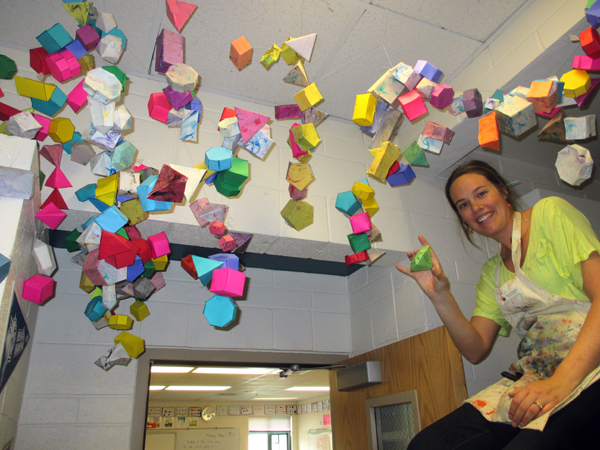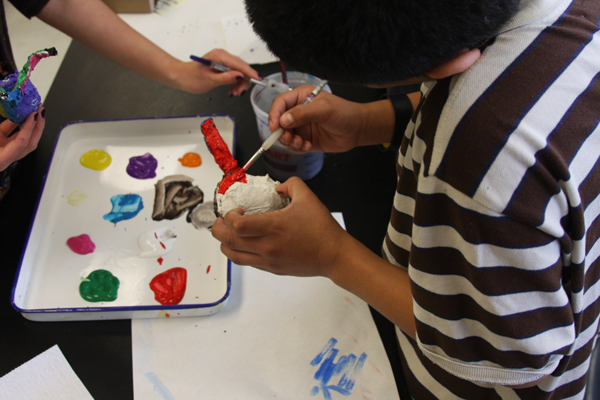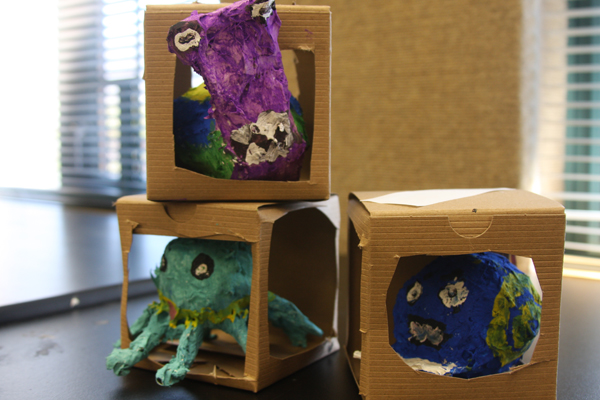By Katelyn Foley
Artist-In-Residence programs, in the traditional sense, exist to give time and space for artists to focus on creative enterprises. While many programs of this type continue to provide this opportunity for artists, museums and other cultural organizations are looking at the model as an audience engagement or educational outreach opportunity. I have had the opportunity to work on a pilot program that has developed into a strong element of museum educational programming. Throughout the development of this programming I have met other museum colleagues who are exploring various other residency outreach models and we are hungry to hear of other programs in the field.
My experience with a new residency program is at Sun Valley Center for the Arts (SVCA) working on the development of the Classroom Enrichment program. SVCA is the largest arts organization in Idaho serving the Blaine County community, which includes one public school district and various private schools; roughly a student population of 4,000. The Center developed a strong partnership over the years with local schools and found that arts opportunities in school decrease for students at the secondary level (6th–12th grades). We also noted that participation in SVCA’s programming decreased with students entering 6th grade. The Classroom Enrichment program was developed to provide these students with an arts experience in the traditional classroom setting by integrating the arts into core subjects (math, science, humanities, English, and language arts). (For more information on arts integration, visit the Kennedy Center’s site ArtsEdge.) The goal of the program is to engage students in a creative process that links to another subject area to enhance the learning experience and aid in topic retention. In addition SVCA instills creative skill building and renews the relationship these students developed with Center programming during their earlier years in school.
The Enrichment projects pair teaching artists with core classroom teachers, who work together collaboratively to address and reinforce specific learning objectives. Teaching artists and classroom teachers develop an arts-based project centered on the learning objectives. For example, a 7th grade life science teacher worked with our teaching artist to develop a project that would reinforce her unit on mollusks. Students are required to know the anatomical features of a mollusk, thus the visual art project focused on the creation of paper mâché mollusks. Each student was tasked with creating a new species of mollusk complete with mantle, radula, eye spots, shell and a foot. Working within those parameters, inspired by the work of contemporary artists such as Christopher Marley and Rafael Gomezbarros, the 7th graders created individual mollusk creatures. The students not only learned the function of a radula and mantle, but also how to manipulate new materials and employ creative problem solving skills to accomplish their goal. As a final step the students gave their new species a scientific name, wrote a poem describing their creature and created a display for their work in the hallway.
Photo by Katelyn Foley
Paper mâché mollusks made by students. Photo by Katelyn Foley
Other enrichment projects include creating marbleized paper and building 3D gem shapes to scale in geometry, illustrating the layers of a fictionalized character with tunnel books in language arts, and exploring peace and conflict in the Middle East through theatre exercises in humanities.

Photo by Dev Khalsa Photography.
Through our assessment of the projects in the 2014-15 school year, we found that 87% of students were inspired to think about the academic content being presented and 91% developed new skills while working on the project. When we surveyed the teachers, 75% found that incorporating an integrated arts project was more effective than their normal teaching strategies alone, and 100% of them plan to use elements of the project in their future teaching. One teacher wrote, “My students were so engaged in this work that they barely realized how hard they were thinking about measurement, scale and surface area…Instead of being an added stress to my instructional planning, it felt like an opportunity for me to collaborate and use our collective creativity to design and implement a meaningful experience for my students.”

A Teaching Artist shows off students' gem installation. Photo byDanica Robrahn.
As museum educational programming is increasingly challenged in reaching audiences because of limitations with transportation, class time and other resources, residency programs offer the opportunity for new innovative programming that takes place in the classroom. By responding to particular needs within the community, these programs expand the scope of how organizations meet their mission. I look forward to learning about other such programs taking shape in classrooms and schools!
To see our Classroom Enrichment program in action click here.
Katelyn Foley is the Director of Education and Humanities at Sun Valley Center for the Arts in Sun Valley, Idaho. She received a Masters of Art Education from St Michaels College. She has worked in the education department at various museums, including the Shelburne Museum and the Fleming Museum of Art.










Add new comment